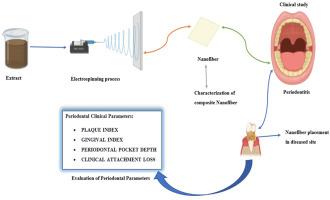Evaluation of nanofiber scaffolds laden Ashvakatri in the management of chronic periodontitis-a randomized, controlled split pocket study
Q1 Medicine
Journal of oral biology and craniofacial research
Pub Date : 2025-08-19
DOI:10.1016/j.jobcr.2025.07.027
引用次数: 0
Abstract
Background
The main objective of periodontal treatment is to stop the progression of periodontal disease. Controlled-release drugs yield promising outcomes when conventional treatment is proven to be insufficient in establishing periodontal health in chronic periodontitis. A low-dose controlled-release delivery method for the treatment of periodontal infection was attempted to be developed in this study. With effective electrospinning, a novel sustained-release medication system including polycaprolactone (PCL) nanofibers containing Ashvakatri (A2) and Tetracycline (TET) was accessed clinically for periodontitis.
Method & materials
The electrospinning technique prepared nanofibers with A2 and TET in PCL and gelatin. The A2-loaded nanofiber followed the Higuchi model release and had a sustained impact of 9 days (220 h). 75 periodontal sites from 31 patients with chronic periodontitis (≥5 mm probing depth) followed by 3 groups: Group I received Scaling and root planning (SRP) and blank polymer mat whereas Group II treated with SRP and PCL-GE-A2 nanofiber scaffold/mat, and Group III received SRP + PCL-GE-TET (tetracycline) nanofiber scaffolds. Clinical evaluations of GI, PI, PPD, and CAL were performed on each patient group.
Conclusion
Compared to the placebo and standard group, the test group was remarkably associated with improved GI, PI, PPD, and CAL at the end of the study. Therefore, drug-loaded nanofiber was found to be efficacious in treating periodontal diseases and may be appropriate as an alternative treatment.
Clinical significance
The fabricated PCL-GE-A2 nanofiber mat was more cost-efficient, minimized the dosage amount, and dosage frequency, and showed no adverse effects or discomforts with increased patient compliance.

纳米纤维支架在慢性牙周炎治疗中的应用——一项随机对照裂袋研究
牙周治疗的主要目的是阻止牙周疾病的发展。当常规治疗被证明不足以建立慢性牙周炎的牙周健康时,控释药物产生了有希望的结果。本研究试图建立一种治疗牙周感染的低剂量控释给药方法。采用有效的静电纺丝技术,建立了含阿什瓦卡崔(A2)和四环素(TET)的聚己内酯(PCL)纳米纤维治疗牙周炎的新型缓释药物体系。方法材料采用静电纺丝技术在PCL和明胶中制备A2和TET纳米纤维。在31例慢性牙周炎患者的75个牙周部位(≥5 mm深度)中,将载a2纳米纤维按Higuchi模型释放,持续影响9天(220小时),分为3组:第一组采用刮治和根规划(SRP)和空白聚合物垫,第二组采用SRP和PCL-GE-A2纳米纤维支架/垫,第三组采用SRP + PCL-GE-TET(四环素)纳米纤维支架。对每组患者进行GI、PI、PPD、CAL的临床评估。结论与安慰剂组和标准组相比,试验组在研究结束时GI、PI、PPD和CAL的改善显著相关。因此,载药纳米纤维在治疗牙周病方面是有效的,可能是一种合适的替代治疗方法。临床意义制备的PCL-GE-A2纳米纤维垫更具成本效益,用量和给药频率最小,无不良反应或不适,患者依从性提高。
本文章由计算机程序翻译,如有差异,请以英文原文为准。
求助全文
约1分钟内获得全文
求助全文
来源期刊

Journal of oral biology and craniofacial research
Medicine-Otorhinolaryngology
CiteScore
4.90
自引率
0.00%
发文量
133
审稿时长
167 days
期刊介绍:
Journal of Oral Biology and Craniofacial Research (JOBCR)is the official journal of the Craniofacial Research Foundation (CRF). The journal aims to provide a common platform for both clinical and translational research and to promote interdisciplinary sciences in craniofacial region. JOBCR publishes content that includes diseases, injuries and defects in the head, neck, face, jaws and the hard and soft tissues of the mouth and jaws and face region; diagnosis and medical management of diseases specific to the orofacial tissues and of oral manifestations of systemic diseases; studies on identifying populations at risk of oral disease or in need of specific care, and comparing regional, environmental, social, and access similarities and differences in dental care between populations; diseases of the mouth and related structures like salivary glands, temporomandibular joints, facial muscles and perioral skin; biomedical engineering, tissue engineering and stem cells. The journal publishes reviews, commentaries, peer-reviewed original research articles, short communication, and case reports.
 求助内容:
求助内容: 应助结果提醒方式:
应助结果提醒方式:


